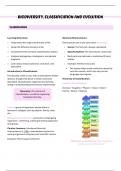BIODIVERSITY, CLASSIFICATION AND EVOLUTION
CLASSIFICATION
Learning Outcomes: Binomial Nomenclature:
o Understand the origin and diversity of life. Every species has a two-part name (Binomen) :
o Grasp the different domains of life. o Genus: The first part, always capitalized.
o Comprehend the Linnaean classification system. o Specific Epithet: The second part, lowercase.
o Interpret phylogenies, cladograms, and spindle o Both parts are italicized or underlined if hand
diagrams. written.
o Learn about natural selection, evolution, and o Example: Panthera leo (Lion)
speciation.
• The system helps avoid confusion caused by
Introduction to Classification: common names, which can vary across
languages and regions.
The diversity of life is vast, with an estimated 8 million
species, though only about 2 million have been Hierarchy of Classification:
described. Classification organizes this diversity,
Levels of Classification:
aiding in understanding evolutionary relationships.
Domain > Kingdom > Phylum > Class > Order >
Taxonomy: The science of Family > Genus > Species
classification, crucial for organizing
biological diversity.
Taxon: a group of organisms placed within a
taxonomic category such as phylum, family, order
etc.
Biological classification: a process of cataloguing
organisms – delimiting, ordering & ranking organisms
into groups.
Carolus Linnaeus: Introduced binomial
nomenclature in 1758, a standardized system for
naming organisms using two-part scientific names.
Example: Homo sapiens (Human)
Mnemonic to Remember: "Dear King Philip
Came Over For Good Soup."
,Example:
Linnaean Classification System:
Organisms are grouped based on shared
characteristics, reflecting evolutionary relationships.
• Spindle Diagrams: Used to show the
diversity and evolutionary history of different
Domains of Life:
groups, often illustrating the rise and fall of
Three Domains: species over time.
o Bacteria: Single-celled prokaryotes,
characterized by the absence of a nucleus and
organelles.
o Archaea: Also single-celled prokaryotes, often
found in extreme environments, with distinct
biochemistry.
o Eukarya: Organisms with complex cells
Caminalcules:
containing a nucleus and organelles, including
plants, animals, fungi, and protists. • Imaginary creatures invented by Joseph
Camin used in classification exercises to
Concepts in Phylogenetics:
demonstrate the principles of phylogeny and
• Phylogenetic Trees: Visual representations taxonomy.
of evolutionary relationships, showing how
Why Classify Life?
species diverged from common ancestors.
• Classification provides a framework to study
and communicate about biodiversity.
• It helps scientists understand evolutionary
processes and relationships, making it easier
to predict characteristics of organisms.
• Natural Selection: The process by which
organisms better adapted to their
environment tend to survive and produce
more offspring.
• Evolution: The change in the heritable traits
of a population over generations.
• Cladograms: Branching diagrams that
represent the evolutionary relationships • Speciation: The formation of new and
among a group of organisms. distinct species in the course of evolution.
, The Tree of Life:
• Represents the evolutionary relationships 6. Animalia (Metazoa): Multicellular, ingestive
among all organisms. heterotrophs, includes vertebrates and
invertebrates.
• Shows the hierarchy of life from common
ancestors to present-day species.
• Branching Diagrams (Cladograms): Used to
illustrate the evolutionary pathways and
relationships between species.
HIERARCHY OF LIFE:
Life is divided into three domains and six kingdoms.
• Domains:
o Prokaryotes: Eubacteria and Archaea
o Eukaryotes: Protista, Plantae, Fungi,
Taxonomic Classification:
Animalia
Two natural groups:
• Kingdoms:
o Prokaryotes: Lack membrane-bound organelles,
o Prokaryotes:
no nucleus, have circular chromosomes & no
1. Eubacteria: True bacteria, including cytoskeleton
cyanobacteria (use chlorohyll-based
o Eukaryotes: Have membrane-bound organelles,
photosynthesis). None are methanogens
a nucleus, linear chromosomes & cyto.
2. Archaea: Anerobic or aerobic. Extremophiles,
Debates in Classification:
often methane producers, non-photosynthetic.
Some sources recognize five kingdoms, others
o Eukaryotes:
recognize six, combining different domains and
3. Protista: Unicellular, autotrophic, or kingdoms based on criteria like molecular data and
heterotrophic. cell structure.
4. Fungi: Multicellular, saprotrophic heterotrophs Phylogenetics and Cladistics:
(e.g., molds, yeasts).
• Phylogenetic Trees: Show evolutionary
5. Plantae (Metaphyta): Multicellular, relationships and divergence times.
photosynthetic (autotrophic), develops through
• Cladograms: Illustrate shared characteristics
embryonic layering.
among species and their common ancestors.
EVOLUTIONARY THEORY
Morphology: Genetics:
o Homology: Similarities due to shared o Similar nucleic acid sequences indicate
ancestry. relatedness.
o Analogy: Similarities due to convergent o Slight differences suggest close relation; large
evolution. differences suggest distant relation.
o Example: The forelimbs of humans, whales, o Divergence: The greater the differences, the
cats, and bats share the same basic structure, more time since the species diverged from a
indicating common ancestry. common ancestor.




